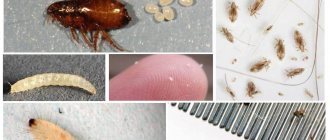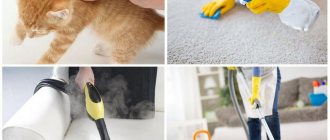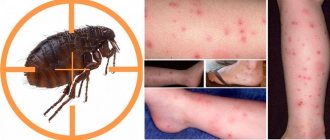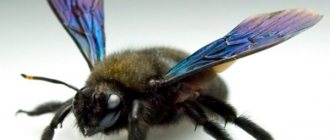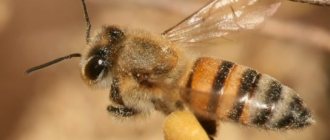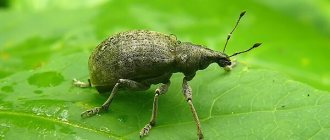Fleas in cats and dogs are a big tragedy. Not only do they harm our pets, but fleas also bite people. But treating fleas in cats and dogs at home is absolutely possible and not so difficult. Here you will learn how to remove fleas from a cat or dog, as well as whether fleas are transmitted from cats to humans. There are several external signs of how you can determine that your pet has fleas: - the cat (or dog) is constantly itching - redness on the skin - hair is falling out in places - the formation of ulcers and scratches at the bite sites
But before taking any measures to combat fleas, you need to be sure of the exact nature of the injuries. If your cat itches behind the ear or just the side, a tick may have attached itself to it.
Fleas are dangerous for animals because they can cause a number of diseases: - mycoplasmosis - helminthiasis - rickettsiosis - dermatitis - anemia - allergic reactions
Fleas on dogs
Dogs need to be walked regularly, so the risk of picking up parasites is high. This usually occurs upon contact with a source of spread (basement, entrance) or with a stray dog. Stray animals are carriers of all kinds of parasites and diseases, so do not allow your pet to come into contact with homeless relatives. The easiest way to protect your dog from fleas is to wear a special collar that repels pests with its composition, but this is only a preventive measure.
Household sprays and sprayers
The market offers a wide range of household flea sprays and foggers. They have a number of advantages:
- high efficiency;
- relative safety compared to pesticides;
- low price;
- also suitable for large surfaces;
- after spraying, the product lasts another 4-8 weeks;
- kills not only the fleas themselves, but also their eggs.
The method of using these products is simple - they need to be sprayed on all surfaces where blood-sucking insects have been noticed. After a day, the treatment can be repeated for greater efficiency, after which a general cleaning of the house can be carried out.
It is strictly forbidden to spray these sprays on human skin or animals. Not suitable for treating pets against fleas.
Fleas on cats
Although usually a cat seems to be a peaceful domestic inhabitant who never leaves the apartment, some cats really like to escape into the entrance hall, where they can pick up parasites on their fluffy fur. The consequences of such a walk appear after a few hours; the pet begins to actively itch, but cannot eliminate the cause of the itching. Sometimes traces of scratching become red, six in these places fall out, and occasionally it comes to bleeding scratches. Try not to let your cat into the entrance or onto the street, and make trips to the veterinarian using a carrier.
What is a flea
The “blood connection” between the ancestor of the dog and the flea arose even earlier than the appearance of Homo sapiens on earth - approximately fifty-five thousand years ago. Of the huge number of subspecies, the “dog flea” lives on dogs - a small (up to 5 mm) brown insect with a flattened body without wings. The structure of the body and three pairs of legs allow the parasite to easily jump on the “victim”, move quickly, hide in the fur, and, if necessary, jump to another owner or temporary carrier.
Important! Fleas reproduce quickly: the population increases to two hundred and fifty adults in a couple of weeks. The dog, its bedding, home carpets, and upholstered furniture are infected. They will also have to be processed.
Symptoms of fleas in an animal
At first, fleas may not show themselves, so it may seem that they appeared “out of nowhere.” If your pet begins to actively and incessantly scratch, this is the first alarming sign. Restlessness, licking and combing fur until bald spots are a clear sign of fleas. Examine the area where you scratched, see if there is any redness or scratches, and treat the affected areas. Spread the fur with your fingers in several places and you can determine the presence of fleas. How to save your pet from suffering?
Anti-flea solutions
Flea solutions are used if pets are infected with fleas. A certain amount of the product is diluted in water, and then the solution is applied to the animal’s fur. These products are very potent, and this is their advantage, because fleas will not have a chance to survive on the animal’s body after such an “attack”, but there is also a huge disadvantage - if used incorrectly, the animal can be poisoned.
It is important to observe all proportions depending on the age, size and weight of the animal; you should not increase the dosage for greater results, this can lead to dire consequences.
Do not use if the pet is too small, sick or pregnant.
Folk remedies for fleas for pets
To rid your pet of fleas, you can use the following safe folk remedies:
- Sagebrush. This product is completely natural and does not contain toxins. To prepare the decoction you will need one tablespoon of wormwood and boiling water. The herb is poured with hot water, after which the decoction should steep for several hours, and, of course, cool. The resulting mixture must be rubbed into the fur and skin of the animal.
- Eucalyptus leaves or tansy are suitable for the same method . But plant decoctions are most often used as prophylactic agents. If there are a large number of parasites, then they will not help here.
- If the infestation is severe, you can prepare a saline solution . Mix table salt and water in equal parts. The solution should be used to treat the carpets in the house, as well as the pet itself. The mixture should be left overnight and cleaned from the carpets in the morning using a vacuum cleaner. Pets are simply combed well to remove parasites.
- Fleas have an extremely negative attitude towards the pine smell . For pets, you can make special beds filled with spruce or pine shavings, and you can add dried wormwood to it.
- Using 3% vinegar essence and cologne , you can also get rid of parasites. The mixture is applied to the pet’s fur, and the animal is covered with polyethylene for several hours, excluding the head. After 30 minutes, the fleas need to be combed out over a basin and the contents poured into the toilet.
- Salt water may also help. You will need 1 pack of salt per bucket of water; you need to dissolve it well and then bathe the animal. Salt can be replaced with wormwood decoction , but you need to carefully ensure that the liquid does not get into the pet’s mouth.
- Along with bathing, you can treat the animal with tar or laundry soap .
How cat flea control relates to their life cycle
Fleas live through four main stages: egg, larva, pupa and adult. The life cycle length varies from several weeks to several months, depending on environmental conditions.
The best approach to flea control is to start with the least toxic (home remedies) and most natural methods, only resorting to stronger measures if no effect is achieved.
Experts and veterinarians recommend taking care of your pets' health at the same time through a healthy diet and lifestyle.
Along with this, it is important to maintain cleanliness and sanitation in the house. Understanding the flea life cycle explains why cleanliness is so important. Adult fleas live approximately 3-4 months. During this time, they continually lay white eggs on your pet that look like dander or salt crystals. Flea eggs mature into larvae that live in cracks and crevices of carpets, linoleum or floorboards, upholstery, blankets, sand, soil, etc.
Since these tiny larvae cannot jump long distances (only 1-2 cm), they feed on black spots of dried blood (“flea dirt”) that fall to the floor along with the eggs while the animal itches and licks its fur.
After 1-2 weeks, the larvae go through the cocoon stage (pupa). After another 1 week, they hatch like small fleas and jump on the nearest host. This cycle takes from 2 to 20 weeks, depending on the temperature in the house or the environment.
Summer is flea season. This is when the cycle lasts only 2 weeks. This is why fleas reproduce so quickly in the summer. In temperate latitudes, flea activity peaks at the beginning of August.
On the one hand, it doesn’t matter how many adult fleas you managed to remove, because a much larger number of them are in the initial stages of development where they are difficult to get. On the other hand, eggs, larvae and pupae are easily sucked up by a vacuum cleaner and removed when washed/washed with water.
An important ally in the fight against fleas is cleanliness, both for your pet and your home, especially in your pet's sleeping areas. Regular house cleaning interrupts flea life cycles and significantly reduces the number of adult fleas.
Flea Control Chemicals for Pets
It is not always possible or convenient to use folk remedies, or you need to immediately get rid of annoying parasites, then chemical compounds come to the rescue. They come in different forms and methods of application, they are very effective, but they must be used with great care! We list the main flea remedies for dogs and cats.
- Anti-flea collars are suitable as prevention , but it is worth remembering that they have a limited validity period, usually several months. As the expiration date comes to an end, you need to buy a new collar. Cats are harder on collars than dogs, so this method is not suitable for everyone.
- There is a remedy similar in action to a collar - drops . They are applied to the animal’s withers, which will prevent it from licking off the active substances that repel and destroy fleas. The drops are quite effective and easy to use.
- More gentle means are powders . They contain a minimal amount of insecticides. Treatment with flea powder needs to be carried out several times, and its validity period is minimal, so it is not in great demand among pet lovers.
- Spray against fleas contains many insecticides and other harmful substances, so its effect is maximum, pests are eliminated instantly. But don't overdo it! Follow the instructions on the package, spray the required amount from the bottle and rub it into the dog or cat's fur. In order to protect your animal from chemical poisoning, wear a special collar to prevent licking of the fur. Spray the substance carefully, do not inhale its vapors and do not get it in the eyes of yourself or your pet!
Drops "Clandestine" for dogs and cats
This is a product with an insecticidal composition that does not irritate the animal’s skin when applied. Flea celandine is available in the form of dispensing pipettes and is effective immediately after use. Its components are effective for about two months.
Disadvantages of the drug:
- Allergic reaction in a pet;
- The animal must not lick the product from its fur;
- The drug should not be used on puppies or kittens up to eight weeks old, or on sick or pregnant pets.
The rules of use and dosage are clearly indicated in the instructions for use.
Attention:
- You can get rid of pests with maximum results if you treat both your pet (especially its place) and the entire room.
- Do not bathe the animal for several days after treatment.
- Wearing a flea collar and treating with Celandine drops are incompatible.
DIY flea shampoo
If you do not trust the composition of the flea shampoo sold in the pet store, or do not want to overpay, prepare your own anti-flea shampoo. For this you will need:
- baby soap;
- medium sized onion;
- egg yolk;
- calendula or chamomile.
The soap is grated using a coarse grater and filled with warm water. The resulting mixture must be brought to a boil to obtain a mass similar in consistency to jelly. You also need to add the grated onion there. Boiled chamomile (can be replaced with calendula) and egg yolk are poured into the finished product and mixed thoroughly. Lather the pet with shampoo, cover it with polyethylene and leave it for half an hour. Then everything is thoroughly washed off.
Anti-flea shampoos
The most popular remedy for fighting fleas on an animal’s body is special shampoos. This product is inexpensive, easy to use, its effectiveness is quite high, and the chance of poisoning an animal is negligible (when compared with solutions). But with all the advantages, there is also a significant disadvantage - the effect of shampoos is short-lived, so if there were a lot of fleas, then you need to wash the animal with this product at least once every 2 weeks. And this is a big problem for those owners whose animals absolutely do not like to wash themselves.
Anti-flea drops
Flea drops are a good remedy for pest control. They slow down the activity of insects and slowly but surely destroy them. The drops create a water-repellent film on the skin and are not washed off when it rains or when the animal is washed.
It is very important to choose the dosage according to the weight of the animal, otherwise too many drops may cause poisoning or allergies, and too little will not have the desired effect.
After you have managed to rid your home and pets of a flea infestation, you need to constantly keep the house clean and take preventive measures against the appearance of pests. With the right approach, the risk of encountering these unpleasant insects in your home again will be minimized.
The danger of advanced cases
Fleas don't just cause trouble for dogs and cats with their bites. They are carriers of more than 20 types of dangerous diseases. These include: hepatitis, pseudotuberculosis, plague, typhoid fever, dermatitis, listeriosis, tularemia. In addition, people can easily contract many diseases from their pets.
In advanced cases, the eyes of a cat or dog begin to water, a rash, small pustules and blisters appear on the skin. Without proper treatment, they burst and turn into ulcers and scabs. Over time, sensitive individuals develop allergic reactions. Incessant itching causes the animal to constantly scratch itself, which leads to the appearance of bald patches and bloody sores.
Advanced flea infestation can lead to anemia. At the same time, the pet becomes lethargic, looks tired and loses weight, and its gums turn pale. Very young and elderly individuals suffer most from anemia. Treatment for this dangerous condition is prescribed by veterinarians.
Symptoms of infection and self-diagnosis
The bites of blood-sucking parasites cause irritation and severe itching of the skin in pets, in some cases accompanied by an allergic reaction. As a result, the animal begins to intensively lick the fur, and some of the fleas are removed. Therefore, it is sometimes difficult to understand that a cat or dog is suffering from fleas - the parasites jump on the animal only while feeding.
If you suspect something is wrong, you need to monitor your pet’s condition. If he is attacked, he begins to itch frequently and sharply, most of all in the area of the head and tail. The animal tries to bite insects, sometimes directly biting into itchy places on the body.
The skin in the affected areas becomes irritated and small red bumps and crusty areas may appear along the back and neck. The hair begins to fall out more intensively, and in advanced cases, bald patches appear. Fleas are carriers of helminths, so the presence of worms in an animal's feces indirectly indicates infection by insects.
Signs of fleas on an animal.
Having appeared in the house, parasites spread throughout its territory - they hide in carpets and other woolen products. The pet cannot hide from them anywhere, and its behavior changes. Owners of a cat or dog can recognize attacks by blood-sucking insects by the following signs:
- the animal avoids its usual sleeping place;
- becomes irritable and restless;
- shakes his head vigorously;
- suddenly jumps up;
- makes plaintive sounds or growls.
You can detect insects using a white cloth and a special comb, the teeth of which are arranged in such a way that fleas get stuck in them, or a comb with fine teeth. The pet is placed or laid on a cloth and its fur is combed from head to tail.
Increased attention is paid to areas on the inside of the paws, the back of the neck and at the base of the tail, where insects most often hide.
During the procedure, either fleas themselves are found in an infected animal - brown insects with a flattened body 2-4 mm long, or their eggs and excrement, which look like a mixture of white and black grains. A drop of water should be applied to the suspicious material. If it contains flea excrement, then when wet, the black grains will turn dark red because they contain blood cells. If there are no signs of infection, but the symptoms do not disappear, you should consult a veterinarian.
Appearance of parasites
Knowing what fleas look like is necessary in order to be able to distinguish these parasites from other types of arthropods, such as ticks.
A flea is a wingless, blood-sucking insect that parasitizes animals and feeds on their blood. Its body shape is oval, slightly flattened at the sides.
The parasite has 2 pairs of short legs, as well as elongated hind legs, with the help of which the insect can push off, making long jumps. Body color is brown or black, length 2–5 mm.
On the small head there is a sharp proboscis, with the help of which the parasite easily pierces the skin of the victim.
At the moment of a bite, the flea injects an enzyme that prevents blood clotting. The body of the parasite is covered with bristles, which help it cling to the animal's fur.
Having reached sexual maturity, the flea begins to lay eggs, from which larvae resembling worms hatch after a few days. After several moults, they grow into adults.
The entire cycle takes about 2 weeks and can increase under unfavorable living conditions.
